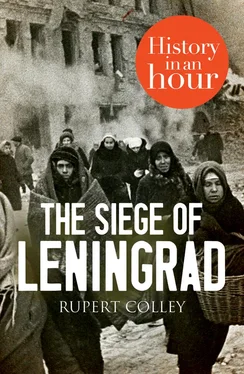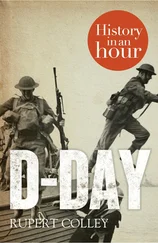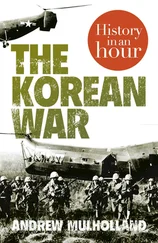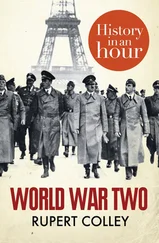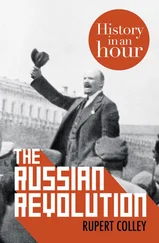The greatest tragedy occurred on 18 August, outside the small town of Lychkovo. One mother remembered her daughter saying, ‘Look, Mummy – a plane! It’s dropping something. Maybe it’s toys.’ The mother flung herself over her child. The planes were German. They flew in low and strafed the train with machine-gun fire then circled round to return, dropping bombs. A scene of utter panic ensued. Amidst the smoke and screams, one witness reported seeing dismembered limbs and children dying. As the planes circled for a third attack, the mothers and children tried to flee across a field only to be shot down by more machine-gun fire.
People were caught in a terrible dilemma. Some thought that perhaps it was safer to evacuate but were reluctant to leave behind their homes and possessions which, in Soviet society, could take years to accrue. Some, requesting to be evacuated, were arrested for being ‘defeatist’; whilst others feigned illness in order not to go. Many felt a sense of shame in leaving, as if they were deserting their beloved city, whilst others wanted to stay in order to welcome in the Germans as liberators. Throughout the war, there was an underlying sense that life under the Germans could be no worse than under the current regime. The Germans were, after all, a ‘cultured people’ that would bring order to the chaos of Soviet life. ‘What about Hitler?’ asked one diarist. ‘He can’t be worse than what we have now and at least they will permit us our churches and praying to God.’
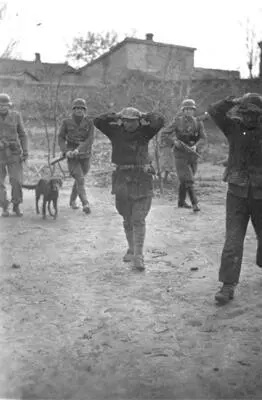
German soldiers taking prisoners
Bundesarchiv, Bild 101III-Niquille-085-10 / Niquille / CC-BY-SA
Many blamed Stalin for the country’s current predicament and lack of readiness, and were disappointed that Stalin hadn’t offered to resign. Such opinions were uttered only in private to loved ones, or occasionally committed to a well-hidden diary. Anyone overheard making such remarks could find themselves reported and arrested. The authorities had no hesitation on clamping down on defeatist talk, ‘loose talk is a crime against the Fatherland’, and asked the population to be its eyes and ears: ‘Let us be vigilant and ruthless in dealing with cowards, panic-mongers, and deserters. Let us establish the strictest revolutionary order’. Hence, outwardly at least, the population displayed great patriotism and loyalty to the city and its regime.
By the end of August over 630,000 civilians had been evacuated. But the city population remained constant as increasing number of refugees, fleeing from the German advance to the west, entered the city. More evacuations were planned, up to 30,000 a day, but when, on 30 August, the town of Mga, 30 miles from Leningrad, was taken by the Germans, the encirclement of the city was virtually complete. There would be no more evacuations. Estimates vary, due to the uncertain number of refugees present in the city, but up to three and a half million Leningraders remained trapped inside. Yet there was only enough food for another three weeks.
The German Advance The German Advance The Men in Charge Under Attack Hunger Death in a Cold City The Road of Life Spring 1942 The Symphony Leningrad Liberated The Aftermath Appendix 1: Key Players Appendix 2: Timeline of Siege of Leningrad Copyright Got Another Hour? About the Publisher Конец ознакомительного фрагмента. Текст предоставлен ООО «ЛитРес». Прочитайте эту книгу целиком, купив полную легальную версию на ЛитРес. Безопасно оплатить книгу можно банковской картой Visa, MasterCard, Maestro, со счета мобильного телефона, с платежного терминала, в салоне МТС или Связной, через PayPal, WebMoney, Яндекс.Деньги, QIWI Кошелек, бонусными картами или другим удобным Вам способом.
By 12 July 1941, the German advance had reached the River Luga, the furthest line of fortifications hastily thrown together by Leningrad’s army of defence volunteers. The Soviet soldiers guarding the defences ran off. ‘The gates to Leningrad are open!’ crowed the German commander. Within just three weeks, the Germans had covered almost 500 miles and were now within 60 miles of Leningrad. Thousands of captured Soviet soldiers were forced to march hundreds of miles west to German prisoner-of-war camps, from which many were never to return. The option to transport them by train was dismissed, lest the Russians should ‘contaminate and soil the wagons.’
When the Germans captured the town of Mga, Leningrad lost its last railway station and its link to the rest of the country was severed. A week later, on 8 September, the Germans captured Shlisselburg on the westerly point of Lake Ladoga. This vast lake, 20 miles to the east of Leningrad, would play a significant role during the siege. Meanwhile, the Finns had advanced from the north, reaching the northern shore of the lake, regaining much of the territory they had lost to the Soviet Union during the ‘Winter War’ of November 1939 to March 1940. Leningrad was now virtually an island, cut off from the rest of the country; its people sealed within. It only remained for Hitler to give the order and the city was there for the taking. But Hitler changed tack and decided not to attack the city but to bomb it instead and starve its inhabitants to death. In his directive, dated 22 September, he articulated his intention to ‘wipe the city of Petersburg from the face of the earth.’
Stalin and Kliment Voroshilov, 1935
Hitler based his decision on pragmatism – the risk of going in was too great. His forces were overstretched and in the first three months of the war, his three armies had already lost 180,000 men on Soviet soil. He could ill-afford further losses. Hitler knew the Russians would fight street-by-street and house-to-house (as proved later in the city of Stalingrad); and his commanders feared also that the city would be mined and its population contaminated with various epidemics. As one German officer concluded, ‘It is not worth risking the lives of our troops. The Leningraders will die anyway. It is essential not to let a single person through our front line. The more of them that stay, the sooner they will die. Then we will enter the city without trouble, without losing a single German soldier.’
The German soldier was under strict orders – anyone caught trying to escape the city, man, woman, or child, was to be shot. However, the German command, aware that shooting unarmed women and children could be detrimental to the mental health of the German soldier, ordered the use of artillery which could be applied from a safer distance.
Thus, on 8 September, the German advance halted just seven miles from the city gates, its troops dug in, and prepared to subject Leningrad to the most devastating siege in modern history. It was to last almost 900 days. To the east of the city a small corridor of land, a tiny chink, remained in Soviet hands between the Finns on one side and the Germans on the other; a corridor that was to prove a lifeline for the besieged Leningraders.
The Men in Charge The Men in Charge Under Attack Hunger Death in a Cold City The Road of Life Spring 1942 The Symphony Leningrad Liberated The Aftermath Appendix 1: Key Players Appendix 2: Timeline of Siege of Leningrad Copyright Got Another Hour? About the Publisher Конец ознакомительного фрагмента. Текст предоставлен ООО «ЛитРес». Прочитайте эту книгу целиком, купив полную легальную версию на ЛитРес. Безопасно оплатить книгу можно банковской картой Visa, MasterCard, Maestro, со счета мобильного телефона, с платежного терминала, в салоне МТС или Связной, через PayPal, WebMoney, Яндекс.Деньги, QIWI Кошелек, бонусными картами или другим удобным Вам способом.
Читать дальше
